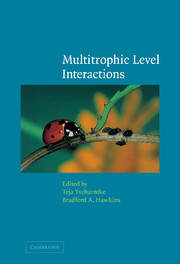
-
Select format
-
- Publisher:
- Cambridge University Press
- Publication date:
- 08 August 2009
- 21 March 2002
- ISBN:
- 9780511542190
- 9780521791106
- 9780521084185
- Dimensions:
- (228 x 152 mm)
- Weight & Pages:
- 0.636kg, 284 Pages
- Dimensions:
- (228 x 152 mm)
- Weight & Pages:
- 0.43kg, 288 Pages
- Subjects:
- Life Sciences, Ecology and Conservation, Zoology
You may already have access via personal or institutional login- Subjects:
- Life Sciences, Ecology and Conservation, Zoology
Book description
The multitrophic level approach to ecology addresses the complexity of food webs much more realistically than the traditional focus on simple systems and interactions. Only in the last few decades have ecologists become interested in the nature of more complex systems including tritrophic interactions between plants, herbivores and natural enemies. Plants may directly influence the behaviour of their herbivores' natural enemies, ecological interactions between two species are often indirectly mediated by a third species, landscape structure directly affects local tritrophic interactions and below-ground food webs are vital to above-ground organisms. The relative importance of top-down effects (control by predators) and bottom-up effects (control by resources) must also be determined. These interactions are explored in this exciting volume by expert researchers from a variety of ecological fields. This book provides a much-needed synthesis of multitrophic level interactions and serves as a guide for future research for ecologists of all descriptions.
Reviews
"Each chapter is technical and well referenced, and makes good use of figures and tables to clarify points. An excellent reference book that also meets its goal as a guide for future research in trophic interactions." Northeastern Naturalist
"Well written and edited...a powerful guide for the next generation of food web studies, in both pure and applied ecology. This book is an interesting, updated review opening many questions about the role of complexity in food webs and I recommend its reading to both graduate students and researchers interested in the ecology and evolution of biotic interactions." Ecoscience
Contents
Metrics
Altmetric attention score
Full text views
Full text views help Loading metrics...
Loading metrics...
* Views captured on Cambridge Core between #date#. This data will be updated every 24 hours.
Usage data cannot currently be displayed.
Accessibility standard: Unknown
Why this information is here
This section outlines the accessibility features of this content - including support for screen readers, full keyboard navigation and high-contrast display options. This may not be relevant for you.
Accessibility Information
Accessibility compliance for the PDF of this book is currently unknown and may be updated in the future.


